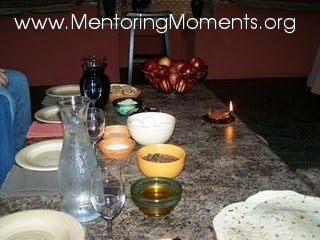On the night of the first Passover, God’s people were instructed to sprinkle the doorposts of their homes with the blood of a lamb. When God smote the firstborn of the Egyptians, He would literally pass over the homes that were marked with blood, and those inside would be spared.
Every time we take communion we think about the last meal Jesus had with his disciples. But rarely do we think about that meal within the context of Passover. Jesus was instituting a new feast and a new covenant that night, but the context of the celebration clearly linked the new with the old. Let’s read the words in the Matthew account in that light:
“While they were eating, Jesus took bread, gave thanks and broke it, and gave it to his disciples, saying, “Take and eat; this is my body.” Then he took the cup, gave thanks and offered it to them, saying, “Drink from it, all of you. This is my blood of the covenant, which is poured out for many for the forgiveness of sins.” Matthew 26: 26-28
Just as the blood of the Passover lamb protected the Israelites from destruction, so Jesus’s blood marks His people as set apart. God’s wrath will pass over us on judgment day as well.
The Christian celebrates communion regularly, and we are not required to celebrate the Jewish Passover anymore. It can be encouraging and instructive to do so, however, especially if the focus is placed where it should be, on Christ our Passover Lamb.
Last year I celebrated a simple Passover meal with my children at an Antiquity museum. It was an enjoyable time of learning more about the Old Testament Passover, as well as a time of thanksgiving and joy as we reflected on our salvation under the new Covenant.
The meal was delicious and traditional to what probably would have been served at the Passover meal in Jesus’ day.
The Menu:
- Hardboiled eggs (a symbol of mourning)
- charoset (a mixture of apples, nuts and raisins which represented the mud used to make bricks)
- bitter salad greens such as horseradish and romaine lettuce (to symbolize the bitterness of slavery)
- parsley with salt water (parsley represents hope and redemption, while the salt water represents tears)
- unleavened bread (the Israelites fled Egypt in haste)
- traditionally a piece of lamb shankbone would be served, symbolizing the Passover Lamb, but the museum substituted chicken since many Americans don’t like lamb
- other traditional foods including apples, nuts, dried fruits, hummus, grape juice, honey, lentil stew, black and green olives.
Everything was placed on the table family style. A meal like this could easily be done at home as a family. As you are eating, talk to the children about the symbolism of the various seder foods. Share some Scripture verses that reflect on Christ, our Passover Lamb, and close the meal with a hymn or prayer.
“Get rid of the old yeast that you may be a new batch without yeast—as you really are. For Christ, our Passover lamb, has been sacrificed. “ 1 Corinthians 5:7
To leave a comment:
- If you are reading this post in email form, click the article headline. This will take you to the article on MMCW’s website.
- Scroll down until you see the box entitled ‘Speak Your Mind’.
- Enter your name, email (it will not be published) and your website or blogsite if you have one (you do not have to have one).
- Click on the big empty space and then begin typing your comments.
- When you are done, click ‘submit comment’. That’s it! We look forward to hearing from YOU!
About Molly Evert
Writer Molly Evert is a wife and homeschooling mom to 6 kids, who range in age from 2 to 18. She runs an educational website, My Audio School (http://www.myaudioschool.com), providing access to the best in children's audio literature. She also blogs at CounterCultural Mom (http://www.counterculturalmom.com) and CounterCultural School (http://www.counterculturalschool.com).
- Web |
- More Posts(146)




